Note the following:
- Leaning back on a chair backrest reduces pressure on the lower back.
- Arm rests that adequately support the weight of the arm reduce lower back stress (not
merely shoulder stress).
- The classic typing posture creates the most pressure on the discs in the lower back (of
these four sitting positions).
Benefits of Reclining and Lumbar Support
4
(Numbers indicate percent of upright sitting posture)
|
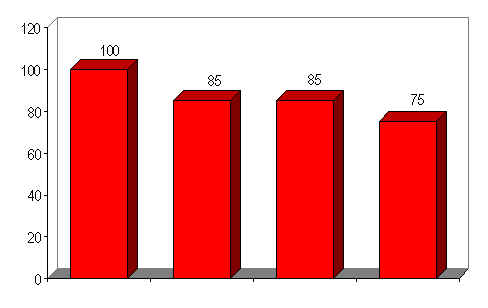  |
90o
upright
(no lumbar support) |
Upright
& lumbar support |
Recline
(no lumbar support) |
Recline
& lumbar support |
Note the following:
- Good lumbar support on chair backrests reduces disc pressure.
- Reclining the backrest reduces the pressure even more.
- Reclining while using good lumbar support yields the least stress on the lower back (of
these four postures).
Contrary to traditional admonitions, leaning back on a chair is not bad for your back. Quite the
opposite, especially if there is proper lumbar support. Note
that the reduction in force on the lower back occurs because some
weight of the upper torso is supported by the back rest, in addition
to putting the spine in its best alignment.
X-Ray Evaluation of Various Postures 5
(Study subjects lying on their sides, on an x-ray table)
 180o
(standing straight)
Vertibrae distorted
Muscles unbalanced |
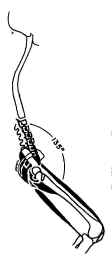 135o
(semi-crouch)
Vertibrae aligned
Muscles balanced |
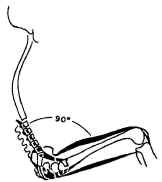
90o
(sitting erect)
Vertibrae distorted
Muscles unbalanced |
As shown in the previous studies, the data suggest that the neutral posture is a
semi-crouch position, not right angles. If you think about it, that's the posture
the astronauts assume when they are weightless.
Static Work Postures and MSDs 6
(Numbers indicate the risk of injury compared to the lowest group)
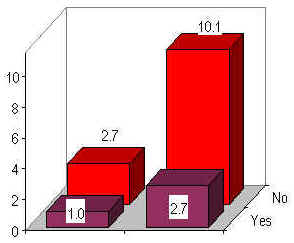 Arm Rests Arm Rests
Extensive Limited
Rest Breaks |
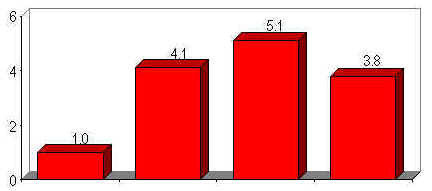 |
No Exposure
and
No Problems |
Static Posture
and
Neck/
Shoulder Problems |
Static
Posture and
Cervical Disorders |
Bent Wrist
and
Hand/Arm Discomfort |
This study was evaluated a group of computer users for problems related to working in
the same position all the time. Thus, the issues here are different from the
strictly posture issues of the previously mentioned studies.
Note the following:
- In the upper graph, limited ability to take rest breaks or to use arm rests was
associated with a ten-fold increase in problems.
- Static postures affect various parts of the body.
|
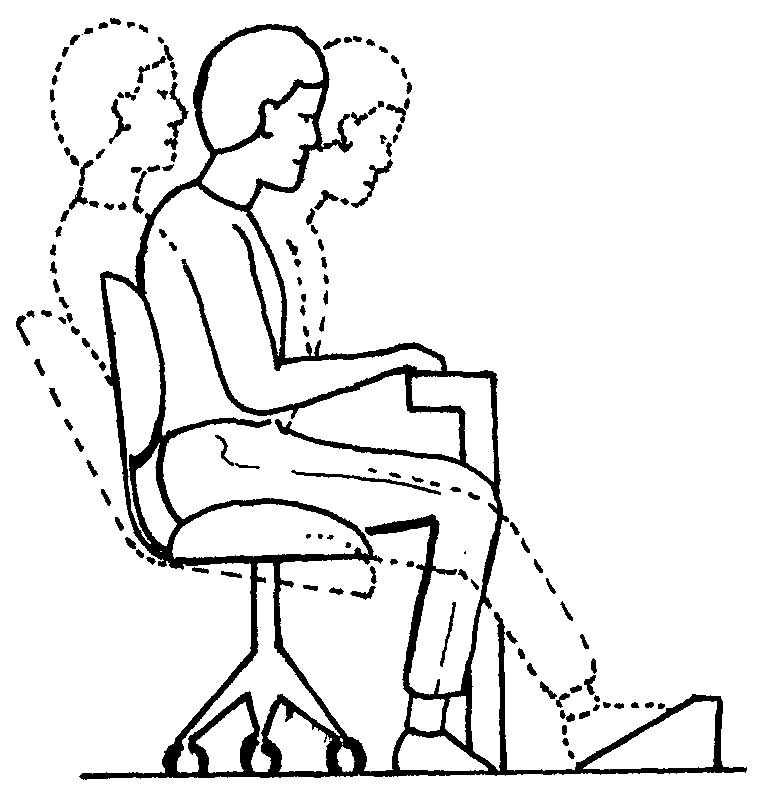 |
|
There is no
single posture that is correct for an eight-hour day.
You must move and change positions. |
The implication is that there is no one single posture that is
correct for a sustained period of time — to stay healthy you need to shift positions and change postures, as
well as stretch and have proper furniture and equipment to keep muscles from being
constantly tense. (This is only one sample study; there are many more on this topic
of static loading of muscles and musculoskeletal injuries.)
Conclusion
Science does not support the recommendation of sitting at right angles. Rather, a
semi-crouched position is better. Furthermore, instead of trying to find the perfect
posture for yourself, you should shift and change.
Personally, I would not conclude that the 90 - 90 - 90 is wrong. There
is still some value in this rule of thumb — it is an easy rule to remember and it can
help you to avoid some extreme postures. The way to think about it is that the rule
can help you get in a starting position from which you can vary.
You can optimize your position if you tilt the chair seat or by angling the back rest
so that you maintain a semi-crouch position. Clearly there is nothing
wrong
with leaning back, as long as you are not slouching, that is, rounding out the
back and having the curve the wrong way.
Technically, it is even better for your back to work almost lying down in a recliner
(see the very first graph again) as long as you have good lumbar support and keep the
correct curves.
In all events, the primary goal is to keep from having the furniture force you to sit
in any one awkward posture.
References:
1Mandal, A.C., 1982. The seated man: theories and
realities. Proceedings of the Humans Factors Society, 520-524.
2Nachemson, A. and Morris, J.M., 1964. In vivo measurements of
intradiscal pressure. J. Bone Joint. Surg. 46A: 1077.
3,4Andersson, G.B.J. and Ortengren, R., 1974. Myoelectric back muscle
activity during sitting, Scand. J. Rehab. Med. 3, 104-114, & Suppl. 3, 73-133.
5Keegan, J.J., 1953. Alterations of the lumbar curve related to
posture and seating. J. Bone Joint Surg. 35A(3) 592-
601.
6Bergkvist, U., Wolgast, E., Nilsson, B., and Voss, M.,
1995. Musculoskeletal disorders among visual display terminal workers.
There are more summaries of key studies like this in
my published books.
